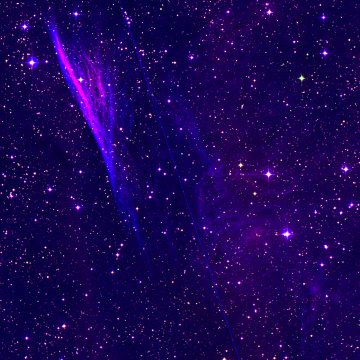RCW 37
Coordinates: (266.89°, 0.11°)
[ Catalog | Explorer | SIMBAD ]
The filamentary nature of the Pencil nebula strongly suggests an association with a supernova remnant. A 2001 study associates it with the supernova remnant RX J0852.0-4622, also known as the Vela Junior supernova remnant. However, another 2001 study rejects this idea and argues that Vela Junior is located much further away. Even more recent papers suggest that this debate is still unresolved and the distance and age of Vela Junior are both still uncertain.
A rival theory in the scientific literature is that the Pencil nebula is associated with Knot D at the edge of the main Vela supernova remnant.
You can see a beautiful image of the Pencil nebula here and an even more detailed Hubble image here.
Is not associated with the Vela Jr. SNR.[2]
Associated with the SNR RX J0852.0-4622[3]
Argues that the Pencil nebula is a supernova remnant located within the shell of the main Vela supernova remnant and hence has the same distance of 250 pc. [4]
Notes
1. ^ Sankrit, Ravi, Blair, William P., & Raymond, John C. (2003). "Optical and Far-Ultraviolet Spectroscopy of Knot D in the Vela Supernova Remnant", The Astrophysical Journal, Vol. 589, 242-252. [2003ApJ...589..242S]
2. ^ Slane, P., Hughes, J. P., Edgar, R. J., et al. (2001). "Nonthermal X-ray emission from G266.2-1.2 (RX J0852.0-4622)", Young Supernova Remnants, Vol. 565, 403-406. [2001AIPC..565..403S]
3. ^ Redman, M. P., Meaburn, J., O'Connor, J. A., et al. (2000). "An Optical Nebula Associated with a Young X-Ray Supernova Remnant in Vela", The Astrophysical Journal, Vol. 543, L153-L155. [2000ApJ...543L.153R]
4. ^ Redman, M. P., Meaburn, J., Bryce, M., et al. (2003). "The Connection between the Vela Supernova Remnant, the Optical Nebula RCW 37, and the Young X-Ray Supernova Remnant RX J0852.0-4622", Revista Mexicana de Astronomia y Astrofisica Conference Series, Vol. 15, 270-272. [2003RMxAC..15..270R]
Distance estimates
250 pc [2003RMxAC..15..270R]Links
[ DSS | ADS | ADS Abstract ]
map | book | blog | gallery | sources

This image was created using the POSS-II/UKSTU data of the Digitized Sky Survey and SuperCOSMOS using the process described here.
According to my correspondence with the Royal Observatory Edinburgh and the Space Telescope Science Institute, I am allowed to use the POSS-II/UKSTU data to create and display images for non-commercial purposes so long as I include this fine print for the SuperCOSMOS data:
Use of these images is courtesy of the UK Schmidt Telescope (copyright in which is owned by the Particle Physics and Astronomy Research Council of the UK and the Anglo-Australian Telescope Board) and the Southern Sky Survey as created by the SuperCOSMOS measuring machine and are reproduced here with permission from the Royal Observatory Edinburgh.
and this acknowledgement taken from the DSS site:
The Digitized Sky Surveys were produced at the Space Telescope Science Institute under U.S. Government grant NAG W-2166. The images of these surveys are based on photographic data obtained using the Oschin Schmidt Telescope on Palomar Mountain and the UK Schmidt Telescope. The plates were processed into the present compressed digital form with the permission of these institutions.
The Second Palomar Observatory Sky Survey (POSS-II) was made by the California Institute of Technology with funds from the National Science Foundation, the National Geographic Society, the Sloan Foundation, the Samuel Oschin Foundation, and the Eastman Kodak Corporation.
The UK Schmidt Telescope was operated by the Royal Observatory Edinburgh, with funding from the UK Science and Engineering Research Council (later the UK Particle Physics and Astronomy Research Council), until 1988 June, and thereafter by the Anglo-Australian Observatory. The blue plates of the southern Sky Atlas and its Equatorial Extension (together known as the SERC-J), as well as the Equatorial Red (ER), and the Second Epoch [red] Survey (SES) were all taken with the UK Schmidt.
The "Second Epoch Survey" of the southern sky was made by the Anglo-Australian Observatory (AAO) with the UK Schmidt Telescope. Plates from this survey have been digitized and compressed by the ST ScI. The digitized images are copyright ? 1993-5 by the Anglo-Australian Observatory Board, and are distributed herein by agreement.
The "Equatorial Red Atlas" of the southern sky was made with the UK Schmidt Telescope. Plates from this survey have been digitized and compressed by the ST ScI. The digitized images are copyright ? 1992-5, jointly by the UK SERC/PPARC (Particle Physics and Astronomy Research Council, formerly Science and Engineering Research Council) and the Anglo-Australian Telescope Board, and are distributed herein by agreement.
The compressed files of the "Palomar Observatory - Space Telescope Science Institute Digital Sky Survey" of the northern sky, based on scans of the Second Palomar Sky Survey are copyright ? 1993-1995 by the California Institute of Technology and are distributed herein by agreement. The compressed files of the "Palomar Observatory - Space Telescope Science Institute Digital Sky Survey" of the northern sky, based on scans of the Second Palomar Sky Survey are copyright ? 1993-1995 by the California Institute of Technology and are distributed herein by agreement.